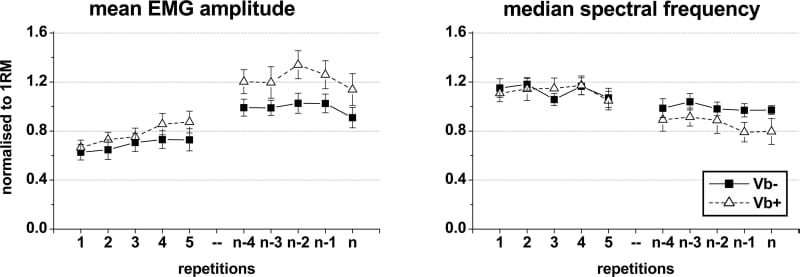The aim of this study was to determine whether vibration alters the time course of neuromuscular fatigue during exercise and in early recovery in man. Eight subjects (4 males, 4 females, 23 ± 2 years, 171 ± 3 cm, 70 ± 2 kg) completed two trials (vibrated or non-vibrated) of unilateral knee extension exercise to volitional fatigue, separated by at least 3 days. Torque, knee joint angle, and vastus lateralis surface EMG activity were recorded simultaneously during metronome-guided knee extension exercise at 35% of one repetition maximum (1RM), completed with (Vb+) or without (Vb-) superimposed vibration-like stimulation (10 Hz, rapid variable resistance) of the leg. Isometric (maximum voluntary contraction, MVC) and dynamic (1RM) strength were tested pre- and post-exercise. Median spectral frequency (MDF) and mean amplitude of muscle EMG activity during the concentric phase of knee extension were calculated for the first and last 5 repetitions and normalised against 1RM values. Data were analysed by repeated measures ANOVA and post hoc paired Students t tests corrected for multiple comparisons using Holm-`idák step-down procedure where appropriate. Data are presented as mean ± SEM. There was no difference between trials in the number of repetitions completed (Vb-, 21 ± 3; Vb+, 19 ± 2). However peak torque was significantly higher and declined more rapidly in Vb+ than Vb- trials (P < 0.05). During Vb+ trials, mean EMG amplitude was significantly higher at the latter stages of exercise, whereas although MDF declined over time there was no difference between trials (Fig 1). Dynamic and isometric strength were significantly lower post-exercise (P < 0.006), but there was no significant main effect of vibration. However the decline in dynamic strength post-exercise was attenuated by vibration (% change post vs pre: Vb-, -23 ± 6%; Vb+, -11 ± 8%). In parallel, MDF was higher post-exercise in Vb+ trials but decreased in Vb- trials (% change post vs pre: Vb-, -12 ± 4%; Vb+, 6 ± 3%, P < 0.05, interaction effect), whilst mean EMG amplitude was higher post-exercise in both trials (% change post vs pre: Vb-, 9 ± 5%; Vb+, 32 ± 11%, P < 0.01, time effect). The classical features of fatigue were evident during exercise i.e. increased mean EMG amplitude alongside decreased MDF and torque. Vibration appears to counteract fatigue, during and after exercise, as indicated by the higher torque probably via recruitment of additional motor units or improved synchronisation.
University College London December 2005 (2006) Proc Physiol Soc 1, PC22
Poster Communications: Acute and acute residual effects of vibration on neuromuscular performance during fatiguing knee extension exercise
Mileva, Katya Nikolova; Evans, Marsha; Bowtell, Joanna L;
1. Academy of Sport, Physical Activity and Well-being, London South Bank University, London, United Kingdom.
View other abstracts by:
Figure 1. Normalised mean EMG amplitude (P < 0.0001; time and interaction effects) and median spectral frequency (P < 0.0001; time effect) for the first and last 5 repetitions in vibrated (Vb+) and non-vibrated (Vb-) trials.
Where applicable, experiments conform with Society ethical requirements.

